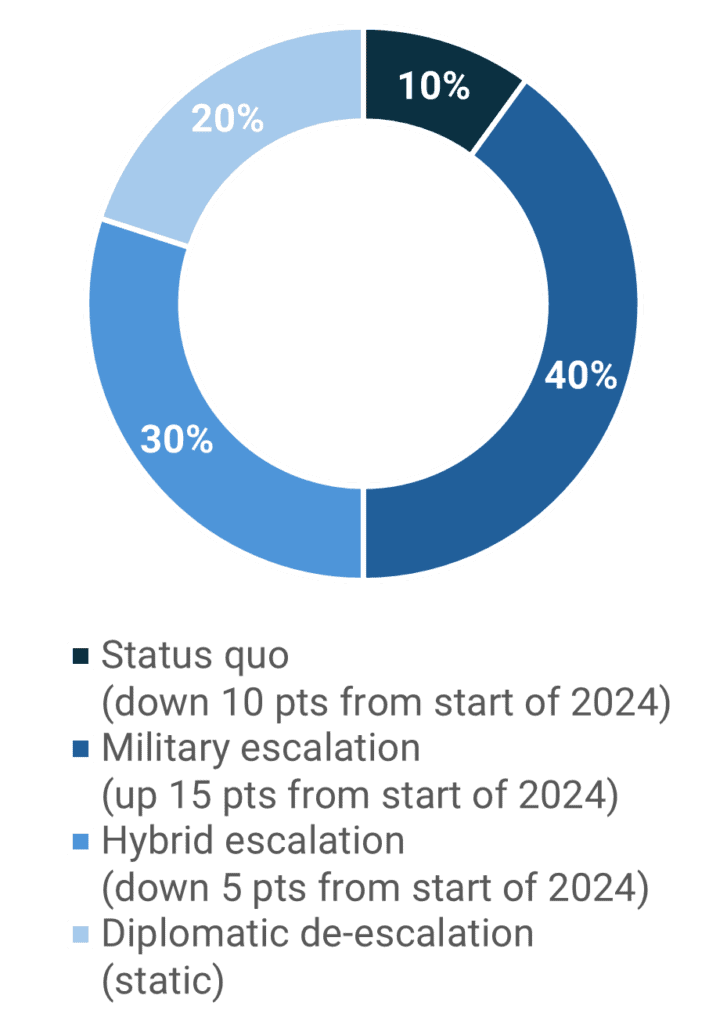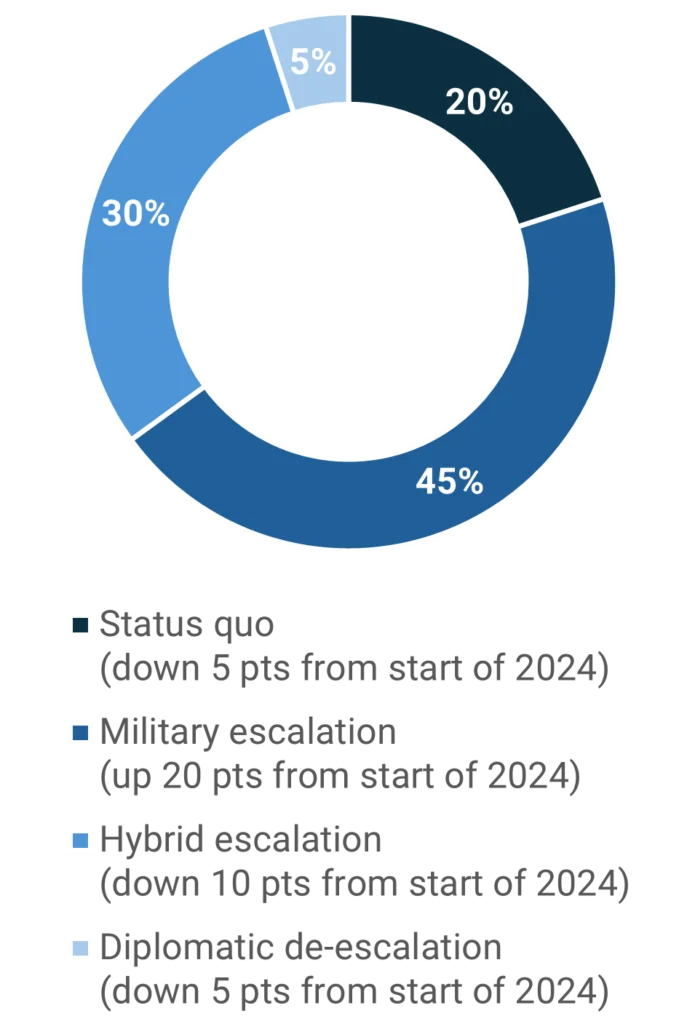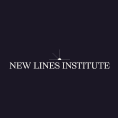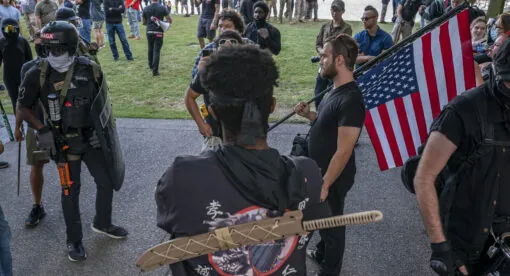The Weekly Forecast Monitor is a forward-looking assessment of geopolitical dynamics that are shaping the international system. To get more in-depth analysis of these issues and learn more about analytical products from New Lines Institute — including simulations, training sessions, and forecast reports — contact us at [email protected] and visit https://newlinesinstitute.org/analytical-products/. Download PDF version.
Global Hotspot Tracker
The Global Hotspot Tracker examines the outlook for key geopolitical hotspots around the world. (Go to the Global Connectivity Tracker)
Middle East
Summary – Tensions in the Middle East trended toward military and hybrid escalation scenarios amid Israel’s ground offensive in Rafah, airstrikes elsewhere in Gaza, and raids in the West Bank. Some EU countries announced their recognition of a Palestinian state, prompting Israel to recall its ambassadors. The Israeli war cabinet approved further cease-fire talks with Hamas. Iran’s president and foreign minister were killed in a helicopter crash.

Military escalation scenario
- Israeli forces advanced toward central Rafah and continued strikes in the city, killing a Palestinian Jihad Organization commander. The IDF recovered the bodies of three hostages from Gaza.
Risk level – medium/high - Israel conducted airstrikes in southern Lebanon, killing a Hezbollah commander.
Risk level – low - Israeli security forces and the IDF conducted raids in Jenin in the West Bank that left at least six civilians dead.
Risk level – low
Hybrid escalation scenario
- The leaders of Norway, Ireland, and Spain announced they would officially recognize a Palestinian state on May 28. Israel condemned the announcement, recalling its ambassadors to the countries and forbidding Spain’s consulate from operating in the West Bank.
Risk level – medium/high - The prosecutor of the ICC has requested arrest warrants for Israeli officials and Hamas leaders for war crimes.
Risk level – medium/high
Diplomatic de-escalation scenario
- The Israeli war cabinet approved the resumption of cease-fire talks with Hamas.
Opportunity level – medium
Russia/Ukraine Conflict
Summary – The Russia-Ukraine conflict is trending toward military and hybrid escalation scenarios as Russia continued its offensive in Kharkiv and other parts of eastern Ukraine and conducted tactical nuclear military drills near the Ukrainian border. The European Council agreed to send profits from Russian frozen assets to Ukraine, while a Russian court ruled to seize assets of two European banks operating in the country. Russia criticized and downplayed the prospects of an upcoming peace summit, though Russian sources suggested President Vladimir Putin is ready for a cease-fire along the current battlefield lines.

Military escalation scenario
- Russia continued its offensive on Kharkiv with drone and missile attacks. Ukrainian forces reportedly recovered some lost ground in the region and have slowed the Russian advance. Fighting continued, especially in the town of Vovchansk.
Risk level – medium - Russia announced tactical nuclear weapons drills close to the Ukrainian border.
Risk level – medium - The Pentagon accused Russia of launching a “counter-space weapon” into low-Earth orbit. Russia’s arms control diplomat, Deputy Foreign Minister Sergei Ryabkov, dismissed the allegation.
Risk level – low
Hybrid escalation scenario
- The European Council agreed that profits from frozen Russian sovereign assets could be used to fund Ukraine, including for Ukrainian military assistance. Kremlin spokesman Dmitry Peskov said the move was a violation of the norms of the global economic system.
Risk level – medium - A Russian court issued a ruling to seize hundreds of millions of dollars of Russia-based assets from Germany’s Deutsche Bank and Italy’s Unicredit amid the European Central Bank advising European lenders to speed up exit plans from Russia.
Risk level – medium - Poland arrested nine members of an alleged Russian spy ring, accusing them of planning acts of sabotage in Europe.
Risk level – low
Diplomatic de-escalation scenario
- Putin is prepared for a negotiated cease-fire with Ukraine along the existing battlefield lines, according to unnamed Russian sources.
Opportunity level – low - Russian Foreign Minister Sergei Lavrov said the June peace summit in Switzerland is meant only to discuss Ukrainian President Volodymyr Zelenskyy’s peace formula as an ultimatum to Russia.
Opportunity level – low
U.S./China/Indo-Pacific
Summary – Tensions in the Indo-Pacific trended toward hybrid and military escalation scenarios. Trade spats between China and the U.S. and EU grew, with China retaliating against recent sanctions by sanctioning U.S. defense firms and launching an anti-dumping investigation. Taiwanese President Lai Ching-te was criticized by Taiwanese opposition and China for delivering a pro-independence inaugural address. Days after Lai’s inauguration, China carried out military drills around the island.

Military escalation scenario
- In his inaugural address, Lai referred to Taiwan’s sovereignty multiple times while also saying his administration will work to maintain the status quo. The speech was seen as escalatory by some Chinese officials who referred to Lai as a “separatist.”
Risk level – medium - Three days after the inauguration, China began a two-day military drill that simulated a blockade of the island. The Eastern Theatre Command of the People’s Liberation Army said the drills’ objective was to “test the ability to jointly seize power, launch joint attacks and occupy key areas.” Taiwan sent military assets to monitor the drill.
Risk level – medium
Hybrid escalation scenario
- China sanctioned 12 U.S. defense firms and their senior officials in response to U.S. sanctions and continued U.S. military support to Taiwan.
Risk level – low - China announced an anti-dumping probe into some chemical imports from the U.S., EU, Japan, and Taiwan in response to Western anti-dumping investigations related to Chinese solar panels and electric vehicles.
Risk level – low - U.S. and EU officials are considering imposing additional sanctions on Chinese entities supplying Russia’s defense industry with microelectronics and high technology. The U.S. and EU said they will continue coordination in countering Chinese overcapacity.
Risk level – low - South Korea and Japan announced new sanctions against multiple North Korean individuals and two Russian vessels for their involvement in shipping North Korean weapons to Russia.
Risk level – low
Diplomatic de-escalation scenario
- China, South Korea, and Japan will participate in a two-day trilateral summit next week, the first in four years.
Opportunity level – low
Global Connectivity Tracker
The Global Connectivity Tracker examines the impact of geopolitical dynamics on key themes like the global energy/climate transition, trade, and technology. (Go to the Global Hotspot Tracker)

Energy/Climate
- United States: Natural Gas
What happened: New liquefied natural gas (LNG) export projects in the United States are facing delays as a result of stricter pollution regulations.
Significance/Outlook: To help fulfill U.S. climate change targets, the Biden administration halted permission for new LNG export projects. The U.S. exported the most LNG in the world in 2023, and those exports are predicted to double by the end of the decade. The LNG production and delivery chain releases methane into the atmosphere, contributing significantly to climate change. New LNG projects will lock the United States into increasing its reliance on fossil fuels for decades. The Biden administration’s delay will give the Department of Energy time to assess LNG export permit applications to verify they meet U.S. energy, national security, and environmental standards.
Risk level – low/medium - United States/Saudi Arabia: Energy
What happened: Saudi oil giant Aramco signed three memorandums of understanding with U.S. companies Aeroseal, Spiritus, and Rondo to develop energy solutions.
Significance/Outlook: The agreement aims to develop potential lower-carbon energy solutions and reduce environmental impact. The deal with Aeroseal explores technology aimed at improving the efficiency of gas pipelines, particularly focusing on mitigating leaks. The deal with Spiritus includes exploring direct air capture technology that lowers energy demands linked to the direct extraction of carbon dioxide from the air. In partnership with Rondo, Aramco aims to explore the deployment of heat battery technology in its global facilities. The agreements underscore the increasing partnership between the United States and Saudi Arabia in the energy sector, especially in terms of advanced sustainable technologies.
Opportunity level – medium - United States/European Union/China: Technology
What happened: U.S. Treasury Secretary Janet Yellen urged the EU to join U.S. efforts to curb Chinese green-tech exports, stating that an oversupply of cheap Chinese goods might threaten manufacturers worldwide.
Significance/Outlook: The White House raised tariffs on Chinese imports across crucial sectors such as steel and aluminum, semiconductors, electric vehicles, batteries, critical minerals, and solar cells. The energy transition agenda and the Biden administration’s plans to bring manufacturing back to the United States from overseas depend on these industries. The new tariffs on Chinese products prevent the surplus from entering the U.S., but it will appear in other countries. China’s increasing manufacturing capability threatens American and Western companies unless they respond in a united way. European countries have claimed they will not join the U.S. in imposing tariffs.
Opportunity level – low - Russia: Oil
What happened: Russian crude oil and refined oil shipments fell to their lowest level in five months in April.
Significance/Outlook: Russia exported 7.3 million barrels per day of crude oil and petroleum products in April, down 6.4% from March. Russian refinery output was lowered because of OPEC’s planned production reduction and recent Ukrainian drone attacks on Russian energy infrastructure. However, Russia made twice as much oil revenue as it did in April 2023 due to higher oil prices. Russian oil profits rose, highlighting Western countries’ inability to cut Russia’s income from oil despite the price cap and sanctions. Russia is exporting oil that had been banned by Western countries to countries like India and China.
Risk level – low - Zimbabwe: Lithium
What happened: Africa’s top lithium producer, Zimbabwe, is seeking to develop the raw material to battery-grade lithium locally.
Significance/Outlook: Four major Zimbabwean lithium producers have proposed plans to refine lithium locally instead of shipping it to China, which currently dominates the lithium extraction industry in Zimbabwe. In the last few years, Chinese companies have invested over 19 billion yuan ($2.6 billion) in acquiring and advancing lithium projects in Zimbabwe. Key companies include Zhejiang Huayou Cobalt, Sinomine Resource Group, Chengxin Lithium, and others. Zimbabwe’s lithium mine production tripled over the past decade, making a shift to a refining economy imperative. Implementing this change will not only boost the economy but will also enhance energy efficiency by reducing dependence on China’s refining capacity.
Opportunity level – low/medium
Key Stats of the Week
- Zimbabwe’s lithium mine production reached a historic peak of 3,400 metric tons in 2023, an increase of 230% from the previous year.
- The International Energy Agency reports that China refines 90% of all rare earth elements and 60-70% of lithium and cobalt.
- China is expected to increase output from its lithium mines, including those it owns in Africa, to 705,000 tons by 2025. This surge could elevate China’s global lithium supply share to 32%.
Source: Oilprice.com





